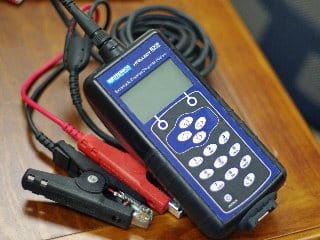
exp1000tester_3695.jpg

Ed’s Battery Tester
I received a nice email from one of my favorite students yesterday asking what my thoughts were on the state of the art in battery testing. I always love hearing from former students and knowing that things are going well, and of course I’m happy to know she’s found www.edsboattips.com
Belinda, thanks for getting in touch! Anyhow, its worth sharing what’s happening in this area because I get questions about this topic fairly often.
Battery testing is a somewhat dynamic area in that as we see new battery technology coming our way, effective test procedures need to get tweaked to get good answers about a battery’s condition. In terms of safety, traditional test methods are potentially very dangerous in today’s world. The primary reason for this is that most batteries today are of the sealed variety. This means you can’t easily see what’s going on inside them and in the case of batteries still using flooded electrolyte, which is certainly the mainstream today, a cell with depleted electrolyte level in a cell is a mini bomb waiting to explode!
For the uniniated, one of the events that can go on inside a battery is a phenomena known as gassing. FYI, the gas is hydrogen which most folks know is explosive. So, if you have a battery cell that is low on electrolyte solution and you can’t open it up to top up the fluid level, the possibility of hydrogen gas building up inside the cell is quite real.
Now, traditional battery testing dictated in part that a really heavy load be applied across the posts. This technique in effect generates a serious short circuit right through the battery and attempts to pull hundreds of amps through. If the liquid electrolyte has depleted below the top surface of the plates inside the cell, the risk of a spark jumping from one plate to another exists. Sparks? Hydrogen? The battery explodes. This is of course not a good place to be if you happen to be the tester. The electrolyte is a mix of water and sulphuric acid. You don’t want to get that on your body!
So, I’ve been a big advocate for what we call “conductance testing” for quite a few years now. This is the safe way to test batteries. But, I hear from a lot of techs that they either don’t always believe what their particular meter is telling them or that they have discovered in one way or another that the machine is just plain telling lies. Well, the short answer is there is truth in all of these discoveries. But, keep reading because the “why” here is extremely important.
Simply, the technology works this way and is based on a singular premise. As a battery ages it’s internal electrical resistance value increases. Why? As sulphate particles begin to coat over the active material of the plates inside each cell, or the actual plate material begins to fall away from the plates, the speed at which the electrical current can travel through the battery, from one post to another is decreased. This inverse relationship needs to be decoded into something meaningful to the person testing the battery so the tester designers will use common specifications such as Cold Cranking Amps,(CCA), Marine Cranking Amps (MCA) and the like to provide some known numbers for the technician to work with.
The idea is simple, if a battery vendor provides CCA information on a battery and you can program that value into a tester, then as the battery ages the tested CCA value decreases from its actual new value down to a certain minimum value (80% of new) we can effectively track battery deterioration and determine what is known as its “state of health”.
So, not to over-simplify this, it is important for the reader to know that the tester designers have a pretty daunting task. Coming up with the mathematical algorithms that can convert the speed of a low level signal being shot through a battery from the tester into a value that makes sense to the technician is not easy. Oh, and don’t forget the tool also has to provide accurate information about a battery’s condition, regardless of size and shape, whether it is a flooded cell, AGM or Gel-Cell, and now of course even newer battery chemistries and technologies such as what we see in hybrid vehicles.
One company rises to the top here in my experience and that is Midtronics, www.midtronics.com .
This company is one of the true pioneers in this arena and they have worked harder than anyone I know of to make the needed adjustments to their products to overcome the accuracy and reliability issues some technicians have run into over the years with this type of tester. Case in point, if you go to their website one of the first things you’ll notice is that they are now touting a tester specifically designed to work with hybrid battery technology. They have come out with an HD version of the tester shown above that I currently use from their EXP series. I use the EXP 1000 but now there is an EXP 1000HD version listed that is designed to work effectively with multiple battery banks (up to six batteries). This in itself is something that those working on larger boats with big battery banks can use.
So in closing, understand this, battery test equipment is a dynamic area and the tester you bought five or six years ago may not be giving you the best information you can get with today’s batteries. Might be time for an upgrade. Ed recommends Midtronics testers.







